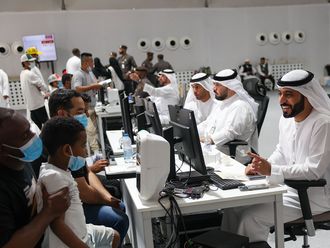
As one of the world’s great success stories in diversified economic development, the UAE is the pre-eminent business and leisure hub in the region. The UAE recognised the importance of investing in education and enabling entrepreneurship as a way to facilitate the growth of a knowledge economy. Becoming a hub for higher education is central to that strategy.
Inbound student mobility: One of the highest mobility ratios in the world
Inbound student mobility to the UAE is enormous and growing at high velocity. As a small country, the UAE has lower total international student numbers than major international study destinations like the United States, the United Kingdom, or Australia. But its inbound mobility ratio of 48.6 percent is easily one of the highest in the world and dwarfs that of all major destinations.
India is by far the largest country of origin of foreign degree-seeking students in the UAE. Indians now make up 17 per cent of all international students. Other top-sending countries are Middle Eastern, like Syria, Jordan, Egypt, and Oman (all sending more than 5,000 students), followed by Pakistan. The numbers are growing at 3 per cent per annum since 2016.
To make the UAE a viable study destination, the government seeks to attract students by offering generous visa policies. Since 2016, foreign students, in Dubai, have been allowed to work part time for designated employers. Exceptionally talented students will now be eligible for a 10-year residency, while other students can get a five-year visa, and dependents [of guest workers] will receive a visa extension to help them get started on their career after graduating.” Universities and government institutions also offer an increasing variety of scholarships for international students.
Outbound student mobility is growing fast
UAE sends approximately 15,000 students abroad per year, a number that has been increasing at around 3-4 per cent per year.
The most popular destination countries among Emirati degree-seeking students are the UK and the US and Canada. In 2016, enrollments in these countries accounted for 30, 27.5 and 20 per cent respectively. By some accounts, more than 90 per cent of students at international schools intend to study overseas after graduation, so this trend will most likely accelerate tertiary mobility.
The outlook for outbound mobility, thus, is favourable and underpinned by the growing demand for education overall.
The US, UK and Canada are the most popular study abroad destinations but recently Germany, Netherlands, Australia have emerged as high growth destinations. The reasons are visa ‘friendliness’ for Arab students and affordability plus work-study pattern for other nationalities.
In Summary
The UAE is both a source and host market, with approximately 58,000 local and 80,000 international student enrolment respectively (60 per cent of these are UAE based residents). Some of the characteristics are:
MARKET ATTRACTIVENESS
● The UAE and specifically Dubai has emerged as a knowledge hub for the GCC and the broader MENASA region. As one of the world’s leading global cities it offers top-class infrastructure and services to enable education and training institutions.
● Consistent growth in K-12 – The UAE has over 1,219 schools, 1,008,000 students and 70,016 teachers
● There are 35 international or internationally accredited campuses located in Dubai alone
STRATEGIC OPPORTUNITY
As a source country the UAE and GCC’s expatriate demand for a HE platform is significant and an opportunity for foreign universities to set up a branch campus
EMIRATI/GCC STUDENTS STUDY ABROAD TO:
● Get a great western-style education and return to get a lucrative UAE government or corporate job
● Avail of the liberal scholarships offered by the UAE and GCC government/select public sector corporates
EXPAT STUDENT STUDY ABROAD TRENDS
● Western expats and some affluent Eastern Expats study in the US, UK and Canada to get a better-quality education/college experience and ‘domicile’ student fees (for citizens).
● Eastern expats return home for highly subsidised public university options or affordable private university degrees that are valid for employment in the UAE after graduation.
● There are two distinct segments for the Eastern Westbound – those who are looking for the best HE money can buy (about 50 per cent of the outbound population) and the rest who are looking for low(er) cost of education destinations such as Germany, the Netherlands, and France, and Caucasian or even Russian universities.
Conclusion
The UAE offers opportunities for international universities to set-up branch campuses in Dubai or the UAE to get closer to their source markets, and this becomes even more important in the post-Covid world with travel and visa restrictions affecting international student enrolments in the US, UK, Canada, Australia and other popular western higher education hubs.
There is also an opportunity for UAE based universities to attract and retain outbound (west or east) resident students by offering better value, leverage the world-class health and safety infrastructure and a more liberal visa and travel regime.
The author recommends a Study in UAE initiative to attract students from the Middle East, South Asia, Africa, Central Asia and China to UAE based universities – an idea he has been advocating for the past five years or so.
In the post-Covid world a travel and tourism destination like the UAE must also think about Edu-tourism where the student traveller has greater stickiness to study and live and hopefully later on work in the UAE, thereby contributing to the local economy and society, and leveraging education for greater competitiveness for the country with a supply of talent for a knowledge-based economy.
- The writer is Managing Director, IMEA, Edorbis DMCC













